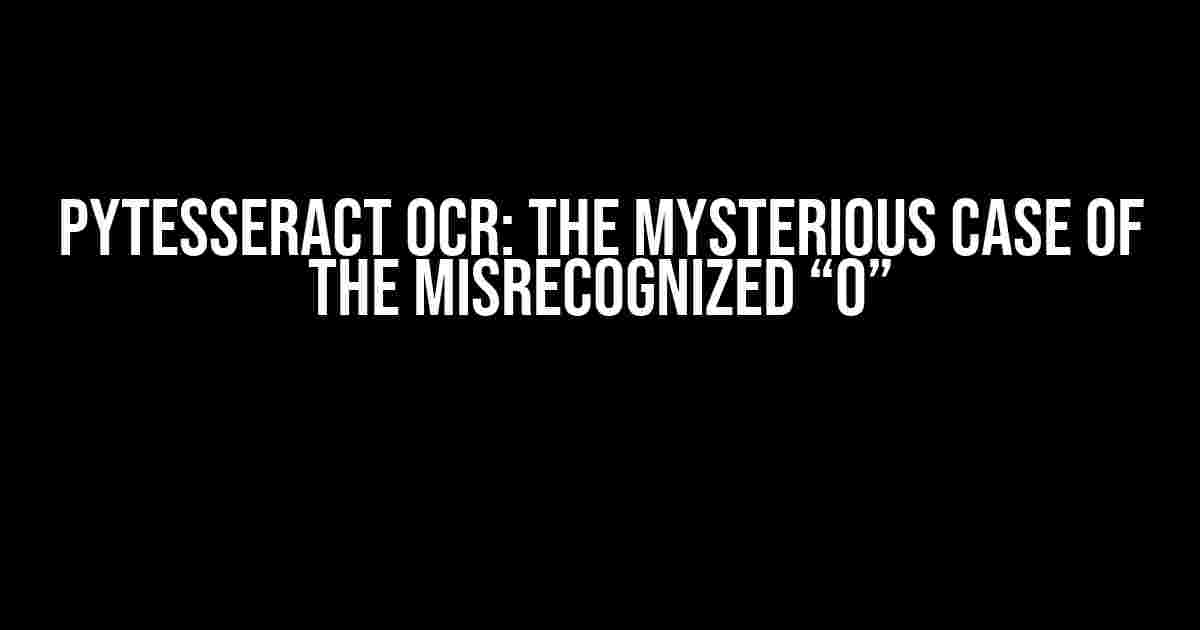Are you tired of Pytesseract OCR recognizing the letter “o” as the digit “0”? You’re not alone! Many developers have struggled with this issue, and today, we’ll dive deep into the world of Optical Character Recognition (OCR) to explore the reasons behind this phenomenon and provide you with practical solutions to overcome it.
The Problem: Pytesseract OCR’s Quirk
Pytesseract OCR, a popular Python library, uses the Tesseract OCR engine under the hood. While it’s an incredibly powerful tool for extracting text from images, it’s not perfect. One of the most common issues developers face is the misrecognition of the letter “o” as the digit “0”. This can lead to inaccurate text extraction, which can be frustrating and even catastrophic in certain applications.
Why Does Pytesseract OCR Make This Mistake?
There are several reasons why Pytesseract OCR might recognize the letter “o” as the digit “0”. Here are a few possible explanations:
- Font and Typography**: The font used in the image can affect the recognition accuracy. Some fonts, especially those with serif or ornate designs, can make the letter “o” resemble the digit “0” more closely.
- Image Quality**: The quality of the input image plays a significant role in OCR accuracy. Low-resolution or noisy images can lead to misrecognition.
- Training Data**: The Tesseract OCR engine is trained on a vast dataset of text images. However, it’s possible that the training data may contain biases or limitations that affect its ability to recognize certain characters accurately.
Solutions to the Problem
Now that we’ve explored the possible reasons behind this issue, let’s dive into some practical solutions to help you overcome it.
1. Pre-processing the Image
One of the most effective ways to improve OCR accuracy is to pre-process the input image. Here are a few techniques you can try:
- Binarization**: Convert the image to binary (black and white) to reduce noise and enhance contrast. You can use OpenCV’s `threshold()` function for this.
- Deskewing**: Deskew the image to ensure the text is horizontal and not tilted. You can use OpenCV’s `warpPerspective()` function for this.
- Image Inversion**: Invert the image to improve contrast. This can be especially helpful if the original image has a light-colored background and dark text.
import cv2
# Load the image
img = cv2.imread('image.jpg')
# Convert to grayscale
gray = cv2.cvtColor(img, cv2.COLOR_BGR2GRAY)
# Apply thresholding
_, thresh = cv2.threshold(gray, 0, 255, cv2.THRESH_BINARY_INV + cv2.THRESH_OTSU)
# Save the pre-processed image
cv2.imwrite('preprocessed.jpg', thresh)
2. Customizing Pytesseract OCR
Pytesseract OCR provides several options to customize its behavior. Here are a few tweaks you can try:
- Page Segmentation Mode**: Try using the `psm=6` mode, which is optimized for text extraction from single-column documents.
- OEM (OCR Engine Mode)**: Experiment with different OEM modes, such as `oem=1` or `oem=2`, to see if they improve accuracy.
- LANG**: Specify the language of the text using the `lang` parameter. This can help the OCR engine adapt to the specific language’s character set.
import pytesseract
# Load the pre-processed image
img = cv2.imread('preprocessed.jpg')
# Set custom options
custom_config = r'--oem 1 --psm 6 -c tessedit_char_whitelist=abcdefghijklmnopqrstuvwxyz'
# Extract text using Pytesseract OCR
text = pytesseract.image_to_string(img, config=custom_config)
print(text)
3. Post-processing the Output
Sometimes, even with pre-processing and custom options, Pytesseract OCR may still make mistakes. That’s where post-processing comes in.
One simple approach is to use regular expressions to replace any misrecognized characters:
import re
# Extract text using Pytesseract OCR
text = pytesseract.image_to_string(img)
# Replace any misrecognized characters
text = re.sub(r'0', 'o', text)
print(text)
Real-World Applications and Case Studies
Pytesseract OCR is widely used in various applications, from document scanning to image-based question answering. Here are a few real-world examples:
| Application | Description |
|---|---|
| Document Scanning | Extracting text from scanned documents for digital storage or OCR-based search functionality. |
| Image-based Question Answering | Extracting text from images of documents, signs, or other sources to answer questions or provide information. |
| Automated Data Entry | Extracting text from images of forms, receipts, or other documents to automate data entry tasks. |
Conclusion
In conclusion, Pytesseract OCR’s tendency to recognize the letter “o” as the digit “0” can be frustrating, but it’s not insurmountable. By pre-processing the input image, customizing Pytesseract OCR’s behavior, and post-processing the output, you can significantly improve the accuracy of your OCR-based applications. Remember to experiment with different techniques and fine-tune your approach to suit your specific use case.
With these solutions in hand, you’ll be well on your way to creating robust and accurate OCR-based systems that can tackle even the most challenging text recognition tasks.
Frequently Asked Question
Get the inside scoop on Pytesseract OCR recognizing “o” as “0” – all your burning questions answered!
Why does Pytesseract OCR recognize “o” as “0”?
Pytesseract OCR recognizes “o” as “0” due to its dependency on Tesseract OCR engine, which can be prone to misclassification of similar-looking characters. This issue can be resolved by improving the quality of the input image, adjusting the page segmentation mode, or using a more advanced OCR engine.
How can I improve the accuracy of Pytesseract OCR?
To improve the accuracy of Pytesseract OCR, you can try preprocessing the input image to remove noise, enhance contrast, and binarize the image. Additionally, you can experiment with different page segmentation modes, OCR engines, and languages to find the best combination for your specific use case.
Can I use Pytesseract OCR for handwritten text recognition?
While Pytesseract OCR can be used for handwritten text recognition, its accuracy may not be as high as for printed text recognition. To improve the accuracy of handwritten text recognition, you can try using more advanced OCR engines or machine learning-based approaches specifically designed for handwritten text recognition.
What are some alternative OCR libraries to Pytesseract OCR?
Some alternative OCR libraries to Pytesseract OCR include Google’s Tesseract OCR, Microsoft Azure Computer Vision, Amazon Textract, and Readiris. Each of these libraries has its own strengths and weaknesses, and the choice depends on your specific use case and requirements.
How can I correct the recognized text output by Pytesseract OCR?
You can correct the recognized text output by Pytesseract OCR by using post-processing techniques such as spell checking, grammar checking, and dictionary-based correction. Additionally, you can use machine learning-based approaches to train a model to correct the recognized text based on the context and language.


